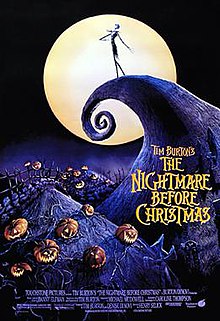 |
| FIG.1- The Cabinet of Dr. Caligari, Theatrical Release Poster (1920) |
The Cabinet Of Dr. Caligari is a 1920's mystery/horror film, directed by Robert Wiene, a film director of German silent cinema. The story is told through a large flashback in a series of 6 acts, through the perspective of Francis (Friedrich Feher). Francis tells us about the events that switched up his life when his best friend was murdered after a day at the fair. The whole film is set as a story of flashbacks, fading in and out of black screens to show us the expressions of our storyteller throughout more clearly as this is a silent film. The film leads us to an odd conclusion with a twist where our storyteller Francis ends up switching places with Caligari in the mental asylum cell.
It has all the key characteristics of the German expressionism movement, from characters having stiff, jagged movements with pale skin and dark eyes, and scenery having pointed edges, uneven buildings and skewed views in reality. German expressionism evolved in the early 1920's due to the post-war era when the Germans were defeated. It can be argued that German expression intertwines with characteristics of film noir. The conventions of film noir and German expressionism are quite similar and really overlap in the fact that they both portray darkness, shadows, urban settings and very extreme chiaroscuro lighting techniques. The Cabinet Of Dr. Caligari was one of the first films to really influence horror films, film noir and incorporate the German Expressionism movement; 'Caligari gave a giant boost to German cinema in the wake of the devastating consequences of World War I.' (Brittanica, 2010). The way this film was structured and shown influenced films we see today such as the works of Tim Burton, whose films appear to come from a similarly built world [Fig.2], where the buildings are distorted along with the perspective of life- giving it a very dark, twisted, film noir flare. We can see a visual comparison between a still from Caligari [Fig.3] and [Fig.2].
 |
| FIG. 2- The Nightmare Before Christmas, Theatrical Release Poster (1993) |
 |
| FIG. 3- The Cabinet of Dr. Caligari, Still |
 |
| FIG. 4- The Cabinet of Dr. Caligari, Still |
As for the structure of the film, The Cabinet of Dr. Caligari is edited in order to give us the best experience with it being a silent film. The cuts and fades into faces close up shots where the characters are internally framed shows us microphysiognomy [Fig.5] to give us a better idea of what the characters are thinking and or feeling rather than having to always have dramatic sounding music or written descriptions. This makes for a very powerful piece of performance. Alongside the visual structure of the film being pleasing, the story itself is told in six separate acts; films are generally told in three acts, set up, confrontation and resolution. Calagari goes against these normalities to arguably give an even more distorted perception of reality, but it can be argued that 'What was particularly interesting about ["Caligari"] was not so much the plot (which could have been better), nor the actors' performance...but first and foremost the utterly novel concept of space." (Heinrich de Fries, 1997:68) So it can be said that although the story is not the best, the way the film is constructed is still very well done, especially given the era it was made in and since it is a black and white, silent film.
 |
| FIG.5- The Cabinet Of Dr. Caligari, Still |
To conclude, The Cabinet of Dr. Caligari is an interesting film, visually a work of art although the story itself is a bit scattered. But part of this can be down to the fact that it is still early in the days of cinema (1920) and being silent could be a disadvantage to some films, but Wiene worked well with this and still brought the story to life in a very interesting way with incredible lighting, shadows and articulated characters.
IMAGES:
Fig.1: The Cabinet of Dr. Calgari (1920) [Poster] At: https://www.cinematerial.com/movies/das-cabinet-des-dr-caligari-i10323 (Accessed on 20 September 18)
Fig.2: The Nightmare Before Christmas (1993) [Poster]
At: http://www.impawards.com/1993/nightmare_before_christmas_ver1.html (Accessed on 20 September 18)
Fig.3: The Cabinet of Dr. Calgari (1920) Directed by: Robert Wiene [Still] At: Screenshot from- https://www.youtube.com/watch?v=EOefuksrW0Y
Fig.4: The Cabinet of Dr. Calgari (1920) Directed by: Robert Wiene [Still] At: http://beatroute.ca/2016/11/05/cabinet-dr-caligari-foreshadows-dark-era/
Fig.5: The Cabinet of Dr. Calgari (1920) Directed by: Robert Wiene [Still] At: http://www.denofgeek.com/us/movies/50-monumental-horror-films/22457/50-monumental-horror-films-part-15
BIBLIOGRAPHY:
Britannica (2010) The Cabinet of Dr. Caligari At: https://www.britannica.com/topic/The-Cabinet-of-Dr-Caligari (Accessed on 20 September 18)
Screenprism (2015) At: http://screenprism.com/insights/article/how-are-point-of-view-and-perception-of-reality-in-the-cabinet-of-dr.-calig (Accessed on 20 September 18)
De Fries, H and Barron, S and Dube, W. (1997) German expressionism: Art and Society 1909-1923: London

2 Comments
An excellent first review Ren - it's good to see you comparing the style of this film with other more contempoary films, such as those by Burton... well done!
ReplyDeleteJust a couple of pointers...make sure that your font is the same size throughout - it gets enlarged in the middle bit there.
Film titles should always be presented in italics, so that it is clear that is what they are, otherwise sometimes you end up with some odd-sounding sentences!
And finally, just make sure you give your writing a quick once-over before posting - you have 'doubled up' here - 'As for the structure of the structure of the film'.
Thank you for the kind words!
DeleteI've fixed these mistakes now, relieved they were some easy fixes! :)